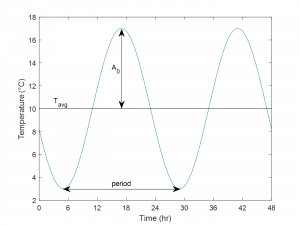13.3 Soil Surface Temperature
The highest and lowest soil temperatures occur at the soil surface. The highest recorded soil temperatures on Earth are near 700°C under an intense forest fire [11]. The lowest recorded soil temperatures on Earth are less extreme, reaching -20 °C in Arctic winters [12]. Regular oscillations in the temperature of the soil surface are driven by the daily cycle of the Earth spinning on its axis and the annual cycle of the Earth orbiting the sun. Irregularities are superimposed on these regular oscillations due to variations in the weather such as the passage of clouds, precipitation events, cold fronts, and warm fronts. If we choose a time period for which such irregularities are absent or negligible, then, as a first approximation, we can represent the soil surface temperature (T0) using a sine wave:
![]()
(Eq. 13-3)
where Tavg is the average soil temperature at the surface, A0 is the amplitude of the temperature oscillation at the surface, w is the angular frequency of the cycle, and f is a phase shift constant. The angular frequency is calculated as , where the period is 24 hours or 365 days. The phase shift is a time offset which is needed to ensure that the maximum and minimum temperatures occur at the appropriate times.


